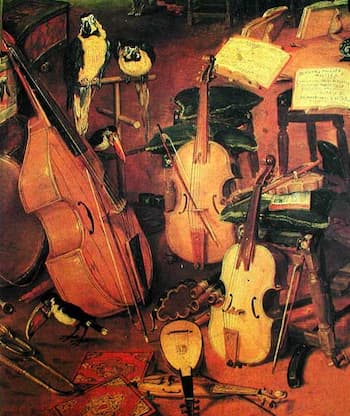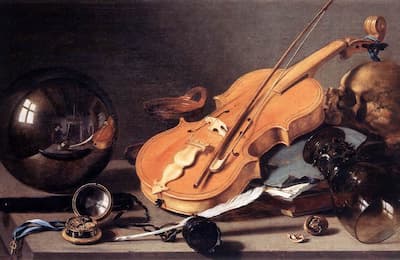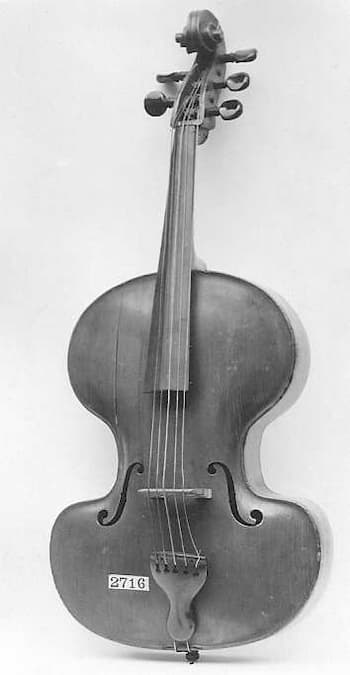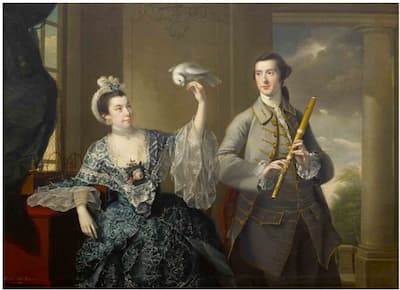
Valentin Daniel Preisler, after a lost painting by
Louis Michael Schneider: Telemann, 1750
Georg Philipp Telemann published his collection Der getreue Music-Meister (The Faithful Music Master) in a set of 25 parts between 1728 and 1729. It was like a musical journal with 70 small vocal and instrumental works mostly by Telemann, and is considered the first German music periodical.
Most of the music in the collection was his own, but he also included pieces by other leading musicians of the day, including Christian Pezold, organist and court composer in Dresden. The music was kept simple, avoiding technical difficulties, and quickly found favour not only for home music making but also at Germany’s courts, where their leading musicians took up the music. One of Telemann’s innovations was the use of German, rather than Italian, tempo, dynamic, and expression markings, eventually creating more German ones than there had been of Italian originals.

Musical instruments and two parrots
In works such as his Viola da Gamba Sonata in G Major, TWV 41:G, he made innovations by making the first movement a dance and setting the whole work in four movements.
Georg Philipp Telemann: Der getreue Music-Meister – Viola da Gamba Sonata in G Major, TWV 41:G6 – I. Siciliana (Simone Eckert, viola da gamba; Ulrich Wedemeier, theorbo; Hamburg Ratsmusik Ensemble)
His G minor Suite was largely made up of dance movements including an unusual final movement ‘Irlandoise.’

Pieter Claesz: Vanitas
Georg Philipp Telemann: Der getreue Music-Meister – Suite in G Minor, TWV 41:g4 – VI. Irlandoise (Roberto Fabbriciani, flute; Carlo Denti, viola da gamba; Robert Kohnen, harpsichord)
In his music journal, subscribers received 4 pages of music every 2 weeks for a total of 68 pieces in a range of styles, including opera arias, small dances, and multi-movement suites and sonatas. The longer works were split up over multiple issues, which was a good marketing ploy to get consumers to buy the next issue, or, better year, take out a subscription. Telemann’s only cello sonata appeared in Der getreue Music-Meister so we can see that he wasn’t using material from other sources.
Georg Philipp Telemann: Der getreue Music-Meister – Cello Sonata in D Major, TWV 41:D6 – IV. Allegro (Gioele Gusberti, cello; Manuel Tomadin, harpsichord)
The index to the publication divides the music by performer: solo keyboard, dessus de viole, solo bassoon, recorder, flute, lute, viola di braccio, viola di gamba, viola pomposa (a kind of oversize viola), solo violin, cello solo.

Josef Klee: Viola pomposa, 19th century (Metropolitan Museum of Art)
The index also has a section for ‘Galanterie’ pieces, such as this piece simply entitled L’hiver (Winter)
Georg Philipp Telemann: Der getreue Music-Meister – L’hiver in D Minor, TWV 41 – d1 (Theodora Schulze, oboe; Dorothy Walters, harpsichord)
Then follows a list of arias and songs, a 3-voice cantata, a duet to be performed with 2 violins, and a fable about a cow. The last section of the index are canons, counterpoints, fugues, and a scene from Telemann’s opera Die verkehrte Welt, which had its premiere in 1728 in Hamburg. Subscribers were getting the latest music!
Georg Philipp Telemann: Die verkehrte Welt – Glückselig ist, wer alle Morgen (Ernst Haefliger, tenor; Ulsamer-Collegium; Josef Ulsamer, cond.)
In this song, for example, Telemann has included an obligato flute part. In a home performance, where many people might have musical training, this provided a bit of something for everyone.

Joseph Wright of Derby: Mr. And Mrs. William Chase, 1760
Georg Philipp Telemann: Der getreue Music-Meister – Säume nicht geliebte Schöne (Ernst Haefliger, tenor; Ulsamer-Collegium; Josef Ulsamer, cond.)
Intended almost as home music lessons, the music in Der getreue Music-Meister not only hit the amateur market perfectly but was also good enough for performance by professionals. Telemann published a number of collections, such as the Essercizii musici and Musique de table, which, along with Der getreue Music-Meister provided nearly encyclopedic surveys of contemporary genres and styles. Simple and accessible, musical and lyrical, the music that Telemann provided was the best for Europe’s growing home audience.
For more of the best in classical music, sign up to our E-Newsletter
